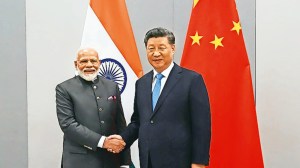Click here to follow Screen Digital on YouTube and stay updated with the latest from the world of cinema.
We Don’t Need No Intermission
For a Hindi cinema familiar, The Interval is a sacred space, arriving bang in the middle of the film.
 But the slicing of the film into two parts is a uniquely Hindi cinema trait.
But the slicing of the film into two parts is a uniquely Hindi cinema trait.
Doing away with the tyranny of the interval would let our filmmakers free to tell the story they want, in one natural, continuous flow
For a Hindi cinema familiar, The Interval is a sacred space, arriving bang in the middle of the film. “The Interval” or “Intermission”, which comes emblazoned on the screen, just in case we miss it, makes it like no other in the world.
The inclusion of the song-and-dance is also a differentiator, but the musical has been a genre that Hollywood has embraced, even if not quite in the same way. Other genres have also used lyrics and songs in the background, as a theme song. Can you remember Love Story without the mushy anthem Where Do I Begin, or Dr Zhivago minus the soaring Lara’s Theme?
But the slicing of the film into two parts is a uniquely Hindi cinema trait, which new-age Bollywood has carried over without a murmur. We’ve got rid of the old-style villain and his den and his moll, the dukhiyari maa, the sobbing sister, the comedy track with the banana peel and the striped underwear. But not the interval, which makes the film, all too often, such an unbelievably Before and After thing.
I have lost count of the number of times I’ve used this sentence in a review: “Post interval, it slides”. Or “slumps”. Or “loses its way”. Or “begins meandering”. Different words, same meaning. All too often, that having to put the film on a pause button before hitting replay, injects it with a stasis that refuses to go away, or colours the rest of it.
Think of what the interval does to a film, even though it’s become something we are barely conscious of : it forces the storyteller to create a faux climactic moment, at a pitch higher than the rest of it till then, whether the plot allows for it or not. And then to have to resume from where it was left off, sometimes having to repeat the last few scenes for those stragglers who return leisurely from loo breaks and concessionaire stands.
And all too often, because of that forced interjection, the filmmaker is unable to sustain the next half. The film’s energy deserts it. It takes a nosedive, and struggles to return to its pitch. Or it becomes a completely different film in both tone and tenor. Either way, it suffers. So do we.
The classic three-act which says that a story must have a beginning, middle and end, gives the plot time to breathe and grow. It gives characters an arc. It gives us, the viewers, time to sink in and absorb. The interval dispenses with all this: it is drama, melodrama, song, and back again. I say, go radical. Throw out the three acts, make it four. Or more. Or stay with one. But do get rid of the tyranny of the interval.
Just imagine, a Bollywood film without that pesky interval. It would allow DDLJ’s Raj and Simran to segue from Southall to the sarson ke khet in one smooth go. If I sit down to add to this list, I could fill up the entire paper. You get the idea, right?
It would let our filmmakers free to actually tell the story they want, in one natural, continuous flow.
When Hindi films of yore, which hadn’t travelled very far from the nautanki styles they imitated, used to routinely run for over three or four hours, the interval acted as a time-out, causing the theatre-owners much glee. Because, and this is not a fact that is known outside the fraternity: it is not the tickets from which the exhibitors make most of their money, but from their concessionaire stands, where you buy overpriced popcorn and cola. Could it be that this has cemented the place of the interval? Or is it just a fear of taking away the familiar from audiences?
Now that the running time of movies is getting scrunched, and high time too, there really is no need for the dreaded interval: we are slowly but surely moving away from insisting that our movies have to be flabby three-hour plus vehicles. We are searching for satisfaction on the value-for-money scale on just the quality of the film. Longer is not always better, unless it is Lagaan.
It is not my case that there should be no pauses at all: my contention is purely to do with the pressure to include this artificial stutter right in the middle of the film. How about creating that pause, or pauses, within the film? With the way the story is told, with the way the character is given a path to turn to?
Will 2015 be that year?


Photos



- 01
- 02
- 03
- 04
- 05




























